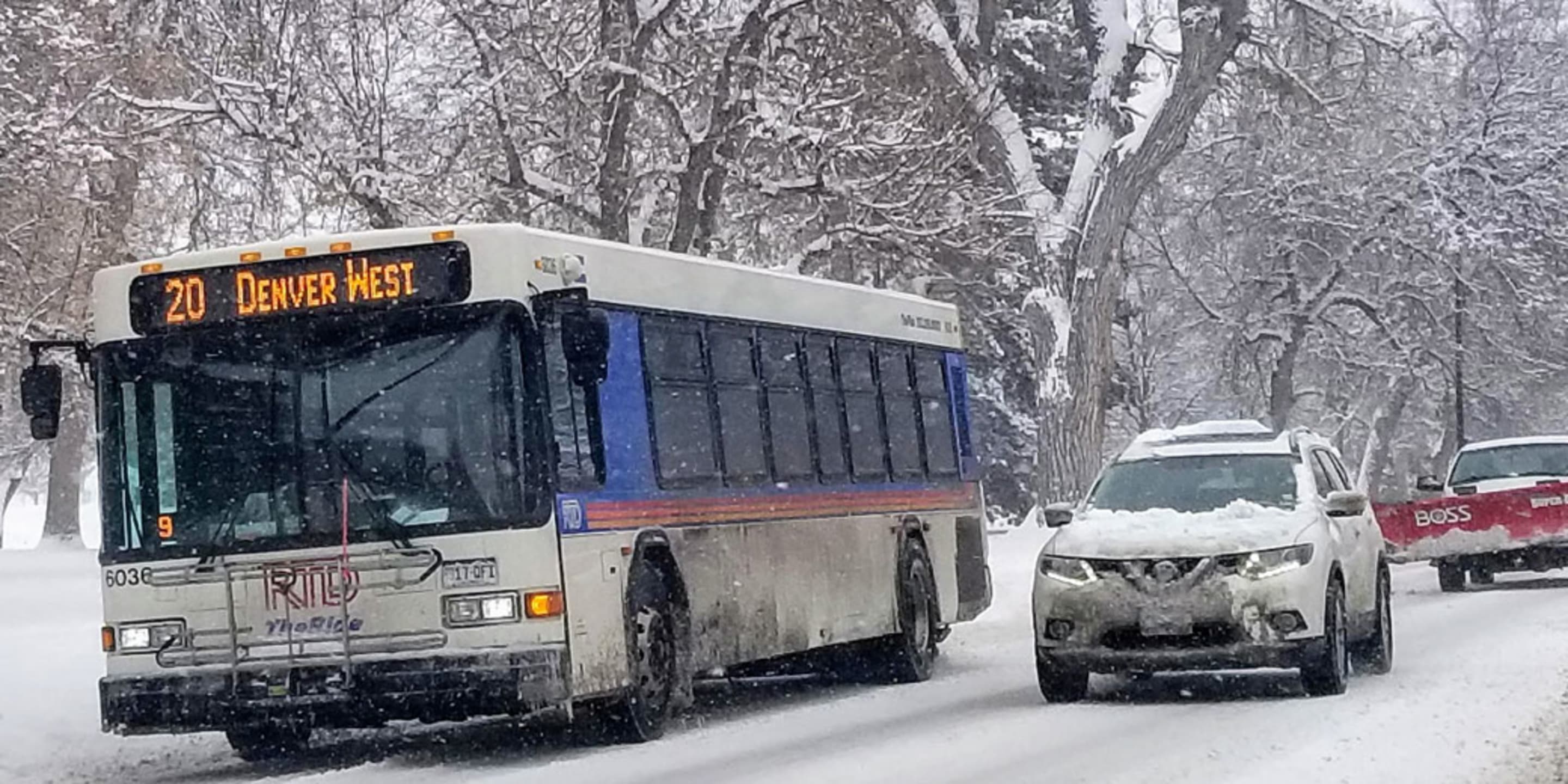
Ever wondered how RTD chains up its buses?
Chaining up a vehicle is hard. Think back to any time inclement weather called for putting chains on a car or truck: Chances are, the experience called for kneeling beside a tire in frigid weather on the side of the road, chains laid out in the snow, straightening and draping them appropriately while trying to maintain feeling in the fingertips.
Now, imagine doing this work on a larger vehicle like a bus, while traffic whizzes by and customers peer curiously from behind a window. This can be the experience of RTD’s bus operators, who are provided with chaining knowledge in initial training and, in most cases, can elect to revisit the topic annually. For those who drive in the mountains or serve on what is called the extra board – enabling operators to pick up shifts as needed – this training is mandatory. RTD routes affected by the chain law include CS/CV, to Pine Junction and Conifer; EV/ES/EX, to Evergreen; and NB, to Nederland and Eldora Mountain Ski Resort. All of the training centers on safety, compliance and helping operators to do what they can to avoid getting stuck in winter conditions.
Teaching the class is Mike Stettenbenz, an eight-year RTD employee who previously worked for agency contractor First Transit and served as a dispatcher at AAA. He also holds experience not a lot of his colleagues have: Stettenbenz obtained a Class A driver’s license and worked briefly as a long-haul truck driver, at one point covering 31 states in 30 days. Carrying a minimum of 80,000 pounds in a 50-foot trailer from a 12-foot tractor, he said, was a “whole different animal.”
There are compelling reasons why bus operators must know how to chain up a vehicle, Stettenbenz noted. “The most important reason is that it’s the law,” he said. Commercial vehicles must carry chains between Sept. 1 and May 31 when traveling along I-70 between Morrison (mile marker 259) and Dotsero (mile marker 133). There are potential penalties for not obeying the chain law, whether for not having chains on a bus at any time of year to not having chains installed when the chain law is in effect. The driver is responsible for paying these fines, not RTD.
Beyond the law requiring it, “The first reason why we do this is for your safety as a customer, so we can get you to and from work, to and from home,” Stettenbenz said. “Secondly, we are trained on how to do it, and retrained on how to do it, so we feel confident that we can get (the bus) chained up and get you home safely.”
Several westbound chain law enforcement signs are along I-70, just before Youngfield, at US 6, just before Morrison and just before Genesee. Designated chain-up areas along I-70 for commercial vehicles are at Denver West, just before Morrison and at Genesee. US 285 has no official chain-up area, but drivers can do so anywhere they deem it safe to pull over. A CDOT sign over the highway just past State Highway 470 informs drivers if the chain law is in effect. Cotrip.org is another source for this information.
RTD operators first learn about winter driving tips, safety procedures and chain installation in the classroom, including when and why the chain law goes into effect. From there, Stettenbenz said, the class moves outside, where operators are shown where chains are stored on a bus and watch an instructor demonstrate how to install them.
“Then they do it themselves,” he added. “It can be hard your first couple times, but once you start doing it and get the rhythm of it, it’s easy to do. The first time you’re by yourself, when you’re actually on the side of the road, you feel like a deer in headlights.” RTD can dispatch mechanics to help in such an event if needed – but the hope is that they won’t need to be, as they likely will be busy with their own work during a storm.
When chain use is called for, two back drive tires on each bus are chained, providing the best traction on snow and ice. An operator lays the chains flat, places them over the top of the tire and stretches the chains until they fit. The bus is moved so that the tire can rotate, enabling the chains to connect. Rubber bungees stretched across the tire keep the chains tight and prevent them from falling off. Chains are removed in reverse order, at a safe location, when the chain law is no longer in effect.
RTD’s mountain-bound and articulated buses also have a snow/mud button, enabling the operator to press a switch if the vehicle is stuck, Stettenbenz said. This action transfers power from the wheels that are slipping to the wheels that are gripping. The agency equips some regional buses destined for the mountains with auto chains, which rotate a chain wheel and throw chain strands into a tire’s footprint with the flip of a switch.
To help get buses unstuck, RTD has traditionally used a traction device called strap chains. The agency is testing a different type of device called an AutoSock, which is easier to install, self-adjusts and is made to fit different bus types. All student operators are now testing the AutoSock on city and mountain routes.